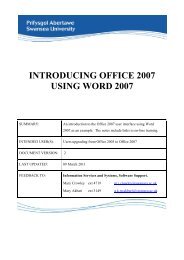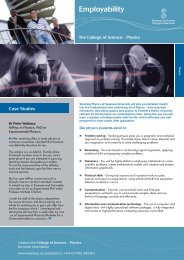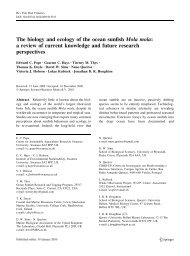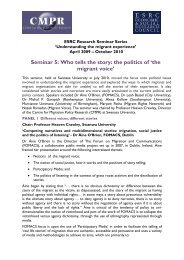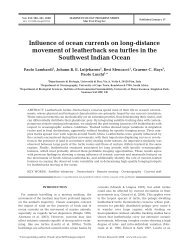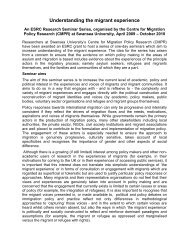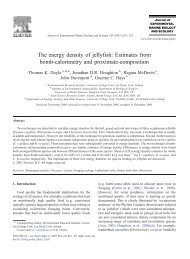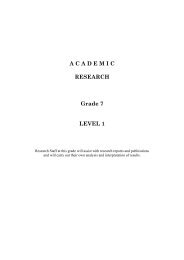Nesting of green turtles (Chelonia mydas) at ... - Seaturtle.org
Nesting of green turtles (Chelonia mydas) at ... - Seaturtle.org
Nesting of green turtles (Chelonia mydas) at ... - Seaturtle.org
Create successful ePaper yourself
Turn your PDF publications into a flip-book with our unique Google optimized e-Paper software.
156 B.J. Godley et al. / Biological Conserv<strong>at</strong>ion 97 (2001) 151±158<br />
4.2. Magnitude <strong>of</strong> nesting<br />
Our methodology is comparable to th<strong>at</strong> used by<br />
Mortimer and Carr (1987), and, therefore, it is evident<br />
th<strong>at</strong> 2±3 times more <strong>turtles</strong> nested in 1998/1999 than in<br />
the surveys in the 1970 0 s. This is worthy <strong>of</strong> cautious<br />
optimism regarding the st<strong>at</strong>us <strong>of</strong> the Ascension Island<br />
nesting popul<strong>at</strong>ion given th<strong>at</strong> many popul<strong>at</strong>ions are<br />
thought to be depleted or endangered (King, 1982). For<br />
some sea turtle popul<strong>at</strong>ions, such as the <strong>green</strong> <strong>turtles</strong><br />
nesting in Pakistan (Asrar, 1999) or le<strong>at</strong>herback <strong>turtles</strong><br />
in Malaysia (Chan and Liew, 1996) and Mexico (Sarti et<br />
al., 1996), there have been precipitous declines in nesting<br />
numbers in recent decades. This is certainly not the<br />
case for <strong>green</strong> <strong>turtles</strong> on Ascension Island. However,<br />
<strong>green</strong> turtle nesting numbers are prone to high levels <strong>of</strong><br />
inter-annual variability (Carr et al., 1978; Schulz, 1982;<br />
Limpus and Nicholas, 1987), and hence continued<br />
monitoring e€orts are necessary in order to identify<br />
whether there have been subtle changes in the size <strong>of</strong> the<br />
Ascension Island popul<strong>at</strong>ion. For cheloniids, such<br />
changes may be identi®ed by intermittent monitoring<br />
over many decades (Hall et al., 1999) and, as such, our<br />
results will become an important component in future<br />
monitoring studies on Ascension Island.<br />
4.3. Sp<strong>at</strong>ial vari<strong>at</strong>ion in nesting e€ort<br />
It is clear th<strong>at</strong> the general present-day distribution <strong>of</strong><br />
nesting is similar to th<strong>at</strong> recorded in the 1970s, with the<br />
same major beaches still holding a large proportion <strong>of</strong><br />
nesting.<br />
4.4. Temporal distribution <strong>of</strong> nesting e€ort<br />
The timing <strong>of</strong> the 1998/1999 season as described is<br />
broadly similar to th<strong>at</strong> presented by previous authors in<br />
preliminary studies (Carr and Hirth, 1962; Carr, 1975)<br />
and extremely similar to the detailed ®ndings <strong>of</strong> Mortimer<br />
and Carr (1987). From the shape <strong>of</strong> the curve <strong>of</strong> the<br />
temporal distribution <strong>of</strong> nesting (Fig. 2) it appears th<strong>at</strong><br />
although not all nests were recorded by beginning surveying<br />
on 1 December a negligible proportion was missed.<br />
This was con®rmed by anecdotal accounts by<br />
Island residents who suggested there had been occasional<br />
nests in November but th<strong>at</strong> nesting in October<br />
had not been observed.<br />
For most popul<strong>at</strong>ions <strong>of</strong> sea turtle, nesting occurs in a<br />
distinct season, usually in the warmest months (Miller,<br />
1996). The reasons for this seasonality are rarely considered<br />
explicitly. On Ascension, Mortimer and Carr<br />
(1987) noted th<strong>at</strong> the turtle nesting season coincided<br />
with the time <strong>of</strong> the year when both highest rainfalls and<br />
highest temper<strong>at</strong>ures were recorded. They suggested<br />
th<strong>at</strong> the timing was adaptive in th<strong>at</strong> <strong>turtles</strong> have diculty<br />
constructing nests in dry sand, thus by nesting in<br />
the wettest part <strong>of</strong> the year, digging would be facilit<strong>at</strong>ed.<br />
If this was the case, nesting success might be expected to<br />
be higher <strong>at</strong> times <strong>of</strong> peak nesting. No evidence was<br />
found to support the hypothesis th<strong>at</strong> the seasonality <strong>of</strong><br />
marine turtle nesting is adaptively linked to higher<br />
rainfall to facilit<strong>at</strong>e nesting as suggested by Mortimer<br />
and Carr (1987). First, nesting success did not vary<br />
during the season. Second, nesting success was not<br />
rel<strong>at</strong>ed to rainfall and third, rainfall only explained a<br />
small proportion <strong>of</strong> the variance in nest numbers in our<br />
multiple regression. We would therefore suggest th<strong>at</strong> prevailing<br />
temper<strong>at</strong>ures are more likely a factor in the explan<strong>at</strong>ion<br />
<strong>of</strong> the timing <strong>of</strong> the nesting season. Mortimer and<br />
Carr (1987) presented d<strong>at</strong>a illustr<strong>at</strong>ing the fact th<strong>at</strong><br />
March and April were the months with most rain. The<br />
variance shown in the mean monthly rainfall for these<br />
months was very high. This is possibly due to the fact<br />
th<strong>at</strong> the magnitude <strong>of</strong> rainfall in these months is dependent<br />
on occasional extreme rainstorms which do not<br />
occur every year.<br />
We found a strong correl<strong>at</strong>ion between the magnitude<br />
<strong>of</strong> nesting and air temper<strong>at</strong>ure. By using the close rel<strong>at</strong>ionship<br />
between air temper<strong>at</strong>ure and sand temper<strong>at</strong>ure<br />
<strong>at</strong> nest depth previously described by Hays et al. (1999),<br />
Fig. 4 shows th<strong>at</strong> during the months <strong>of</strong> negligible or no<br />
nesting (July±October), sand temper<strong>at</strong>ures will exist<br />
which are close to the lower limit <strong>of</strong> the thermal tolerance<br />
range for marine turtle embryos (25±27 C; Ackerman,<br />
1996). On beach 12 most monthly means <strong>of</strong> sand<br />
temper<strong>at</strong>ure during the nesting season <strong>at</strong> nest depth lie<br />
within this range. Turtles may have evolved to nest<br />
during the time <strong>of</strong> highest sand temper<strong>at</strong>ures avoiding<br />
the months where, certainly on beach 12 and other<br />
beaches <strong>of</strong> a high albedo (Hays et al., 1995, 1999), nest<br />
temper<strong>at</strong>ures may get too low.<br />
4.5. Conclusion<br />
In summary, our observ<strong>at</strong>ions con®rm the regional<br />
importance <strong>of</strong> the <strong>green</strong> <strong>turtles</strong> nesting on Ascension<br />
Island and suggest th<strong>at</strong> the st<strong>at</strong>us <strong>of</strong> the popul<strong>at</strong>ion is<br />
favourable. It is clear th<strong>at</strong> this remains a key rookery for<br />
<strong>green</strong> <strong>turtles</strong> in the Atlantic. However, additional monitoring<br />
is clearly necessary to identify whether long term<br />
trends in popul<strong>at</strong>ion size are occurring. With the methodology<br />
presented here, accur<strong>at</strong>e estim<strong>at</strong>es <strong>of</strong> nesting<br />
popul<strong>at</strong>ion size can be obtained which will be directly<br />
comparable among years and popul<strong>at</strong>ions.<br />
Acknowledgements<br />
This work was funded by a grant to GCH from the<br />
Darwin Initi<strong>at</strong>ive for the Survival <strong>of</strong> the Species (UK<br />
Department <strong>of</strong> Environment, Transport and the<br />
Regions; DETR) and was carried out in conjunction



